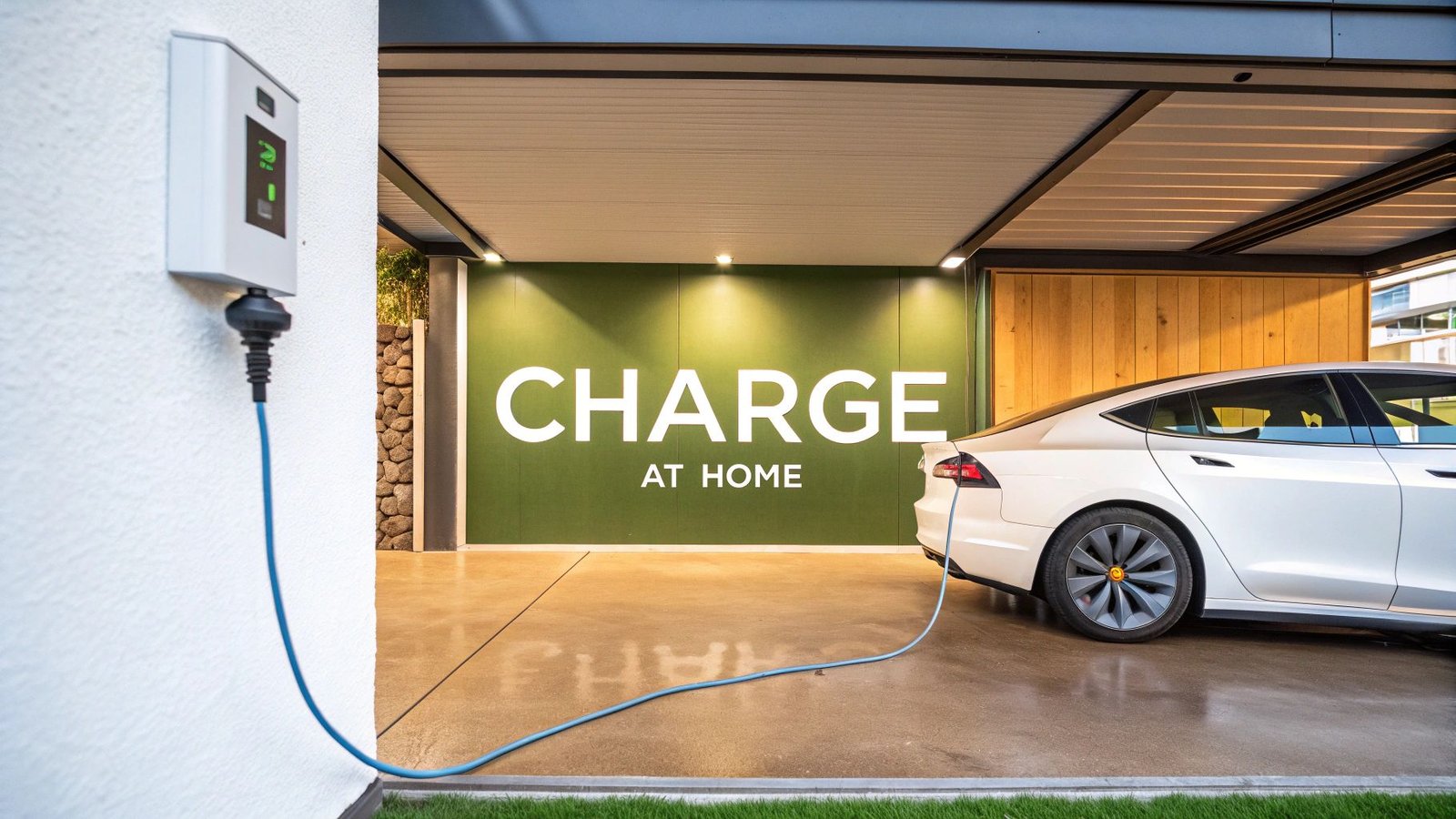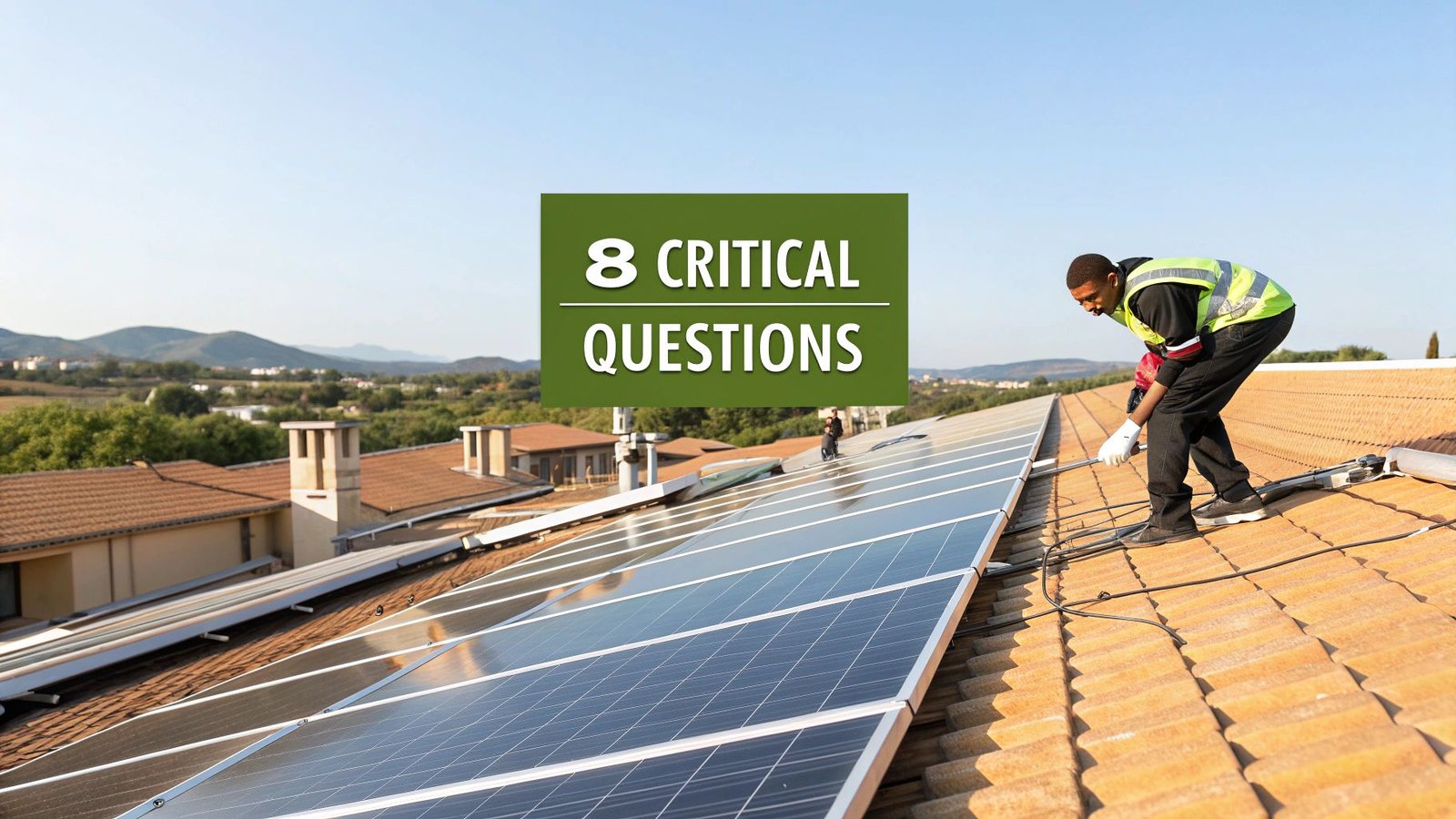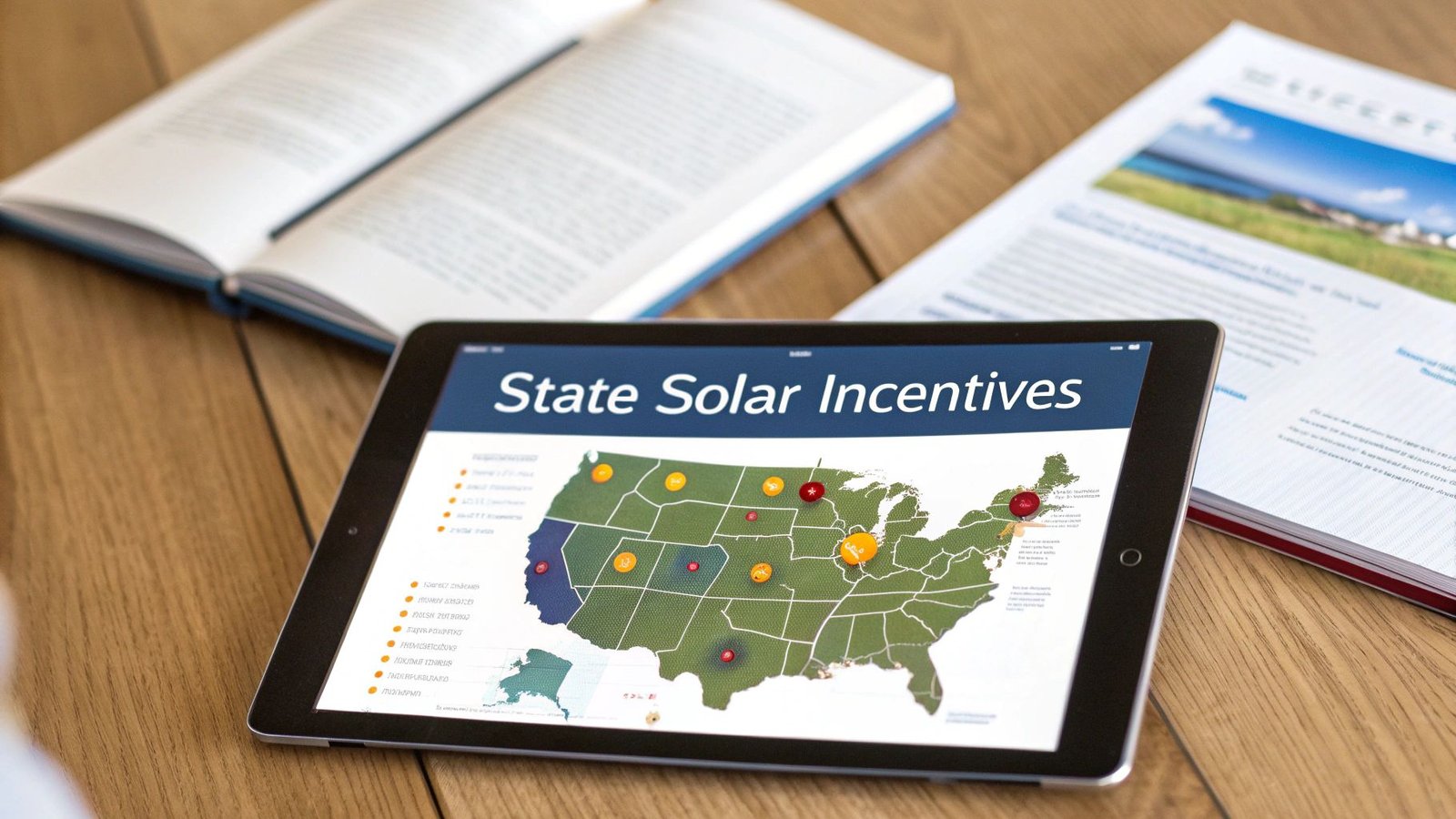Of course you can. For the vast majority of Tesla owners, charging at home isn't just possible—it's the main way they keep their car ready to go. It completely changes the game.
Think of it like plugging in your smartphone at night. You just get home, plug it in, and wake up to a full "tank" every single morning.
The Ultimate Convenience of Home Charging
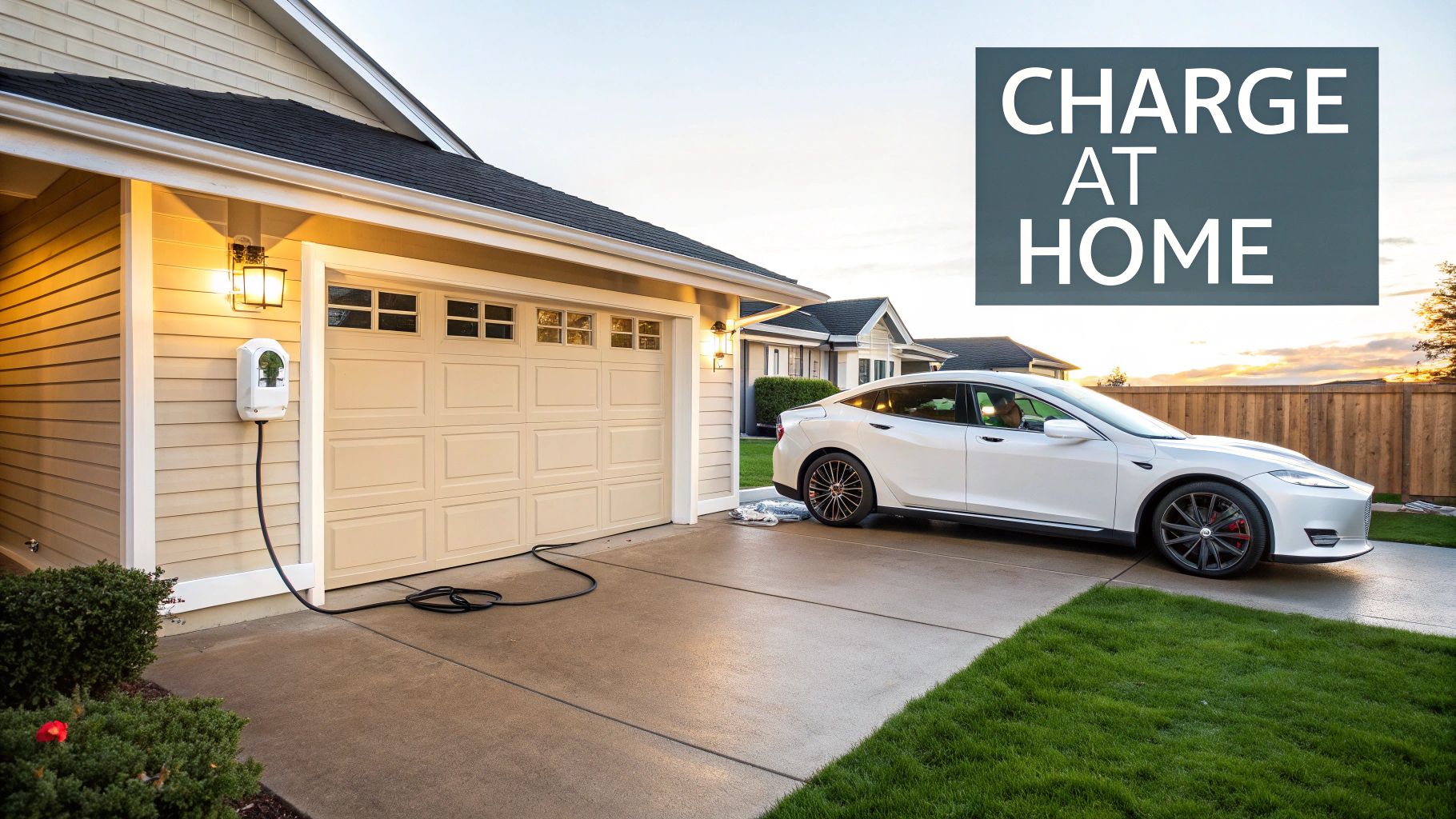
Having the ability to charge your Tesla in your own garage or driveway is what makes owning an EV so effortless. Those weekly trips to the gas station? Gone. Instead of building your schedule around refueling, your car powers up while you sleep, work from home, or just relax.
This has always been a key part of the Tesla experience. In fact, studies show that about 65% of all EV miles driven are powered by electricity from a home charger. With a dedicated Tesla Wall Connector, most owners can add up to 44 miles of range for every hour the car is plugged in—more than enough for even the longest daily commutes. For a deeper dive into how people charge their EVs, this Roland Berger study offers some fantastic insights into charging habits.
The core benefit is simple: Your home becomes your personal fueling station. This shift not only saves you time but also significantly reduces your running costs compared to gasoline.
A Preview of Your Charging Journey
This guide will walk you through everything you need to know to get your home charging set up. We’ll cover all the essentials to make sure you have the right solution for your needs, including:
- Understanding Charging Levels: We'll break down the real-world difference between plugging into a standard wall socket versus a more powerful 240V outlet.
- Hardware Essentials: You've got options. We'll compare the dedicated Tesla Wall Connector with the flexible Mobile Connector.
- Installation Process: Wondering what it takes to get it done? We'll cover what to expect when you hire an electrician.
- Cost Analysis: We'll give you a clear look at both the upfront installation expenses and what you can expect to pay on your electricity bill.
To get started, let’s look at the main ways you can charge a Tesla at home.
Tesla Home Charging Options at a Glance
This table gives you a quick snapshot of the three primary charging methods, so you can see how they stack up in terms of speed, hardware, and what they’re best used for.
| Charging Level | Hardware Needed | Charging Speed (Miles of Range per Hour) | Best For |
|---|---|---|---|
| Level 1 | Mobile Connector + Standard 120V Outlet | 2-5 Miles | Occasional top-ups or low-mileage drivers. |
| Level 2 | Mobile Connector + 240V Outlet Adapter | 15-30 Miles | A great balance of cost and speed for most owners. |
| Level 2 (Fastest) | Tesla Wall Connector (Hardwired) | Up to 44 Miles | The premium, fastest, and most convenient daily charging solution. |
As you can see, your options range from a simple plug-in solution to a professionally installed fast charger. Each has its place depending on your budget, driving habits, and how quickly you need to recharge.
Understanding Your Home Charging Options
So, you've decided to charge your Tesla at home—great choice. But what does that actually look like day-to-day? It's not a one-size-fits-all situation. The best way to think about it is in terms of "levels," where each level offers a different charging speed and requires different gear. It’s a lot like choosing between a standard phone charger and a fast charger.
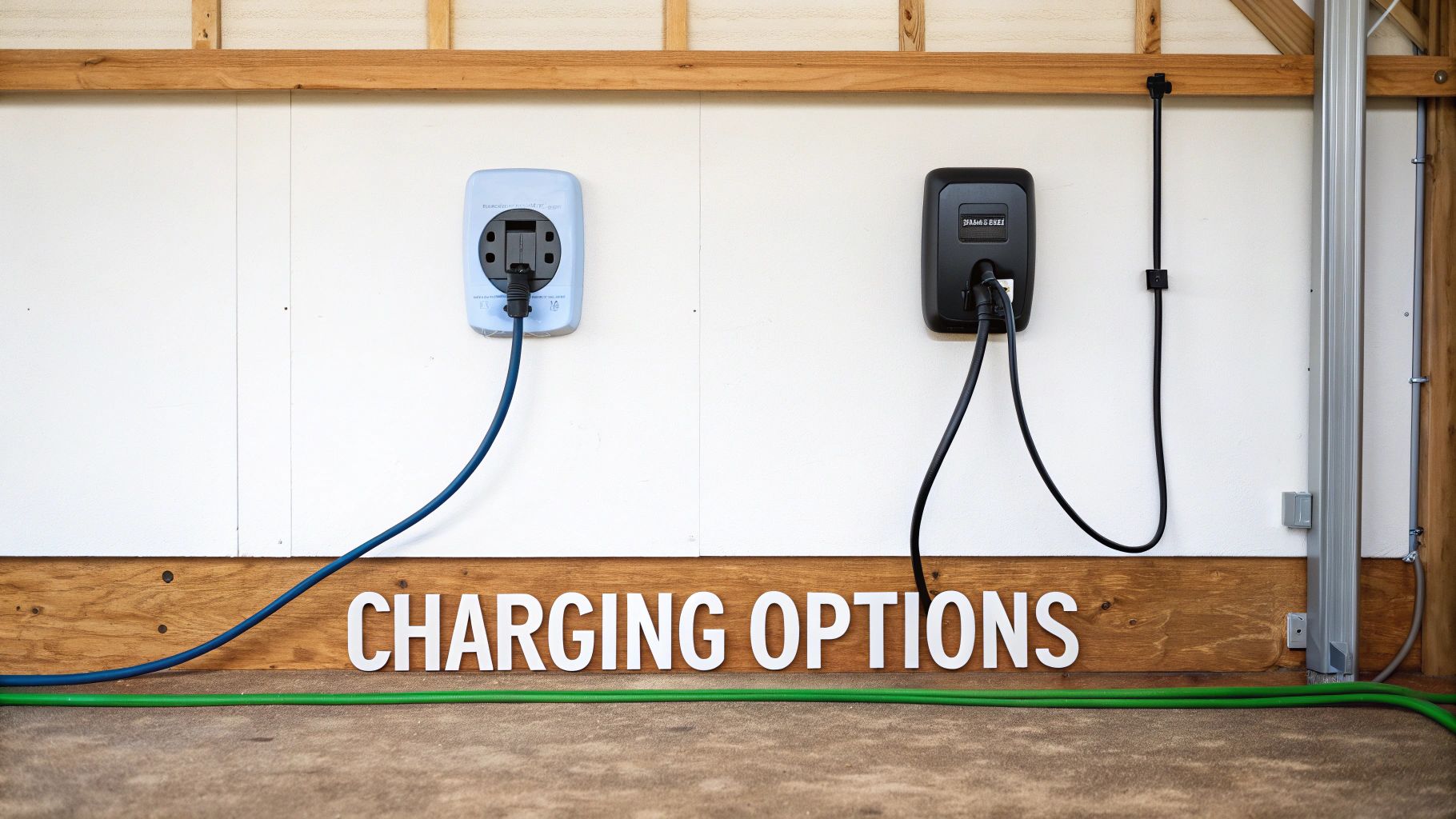
Let's break down these levels so you can figure out what makes the most sense for your driving habits and your home's electrical setup.
Level 1 Charging: The Slow and Steady Approach
The simplest way to get juice into your Tesla is with Level 1 charging. This method just uses a standard 120-volt wall outlet—the same one you’d plug a toaster or a laptop into. All you need is the Mobile Connector that came with your car and its standard plug adapter. No electrician required.
Think of this as a "trickle charge." It's definitely slow, adding only about 2 to 5 miles of range per hour. While that might not sound like much, it can work just fine if you have a short commute or don't drive every day. Plug in for 10 hours overnight, and you'll reliably add 20 to 50 miles, which is more than enough to cover the average American's daily driving.
Key Takeaway: Level 1 charging is the easiest starting point because it works anywhere with a standard outlet. It's a solid backup plan, but most owners who drive more than 30-40 miles a day will find it a bit too slow for their needs.
Level 2 Charging: The Gold Standard for Home Use
For the vast majority of Tesla owners, Level 2 charging is the sweet spot. This setup requires a more powerful 240-volt outlet, the kind you'd see for a large appliance like an electric clothes dryer or an oven. The leap in power is massive, and it slashes your charging times.
With a Level 2 charger, you can expect to add anywhere from 15 to 44 miles of range per hour. The exact speed depends on the specific charger you choose and the capacity of your home's circuit. This kind of speed means that even if you pull into the garage with a nearly empty battery, your car will be fully charged and ready for another long day by the next morning. It really is the perfect blend of speed, cost, and convenience for everyday life.
The Home Charging Speed Spectrum
This chart really puts the difference between Level 1 and Level 2 charging into perspective.
graph TD
subgraph Slower
L1[Level 1 Charging<br>2-5 miles/hr]
end
subgraph Faster
L2_MC[Level 2 (Mobile Connector)<br>15-30 miles/hr] --> L2_WC[Level 2 (Wall Connector)<br>Up to 44 miles/hr]
end
style L1 fill:#f9f,stroke:#333,stroke-width:2px
style L2_MC fill:#ccf,stroke:#333,stroke-width:2px
style L2_WC fill:#bbf,stroke:#333,stroke-width:2px
As you can see, making the jump to Level 2 gives you a huge boost in charging speed, which is why it’s the go-to choice for most drivers. If you really want to take it to the next level, you can pair a Level 2 charger with solar panels. Looking into battery backup systems for homes is another smart move that can lower your energy bills and keep your car charging even during a power outage.
What About Superchargers?
You’ve probably seen them—the sleek, futuristic Tesla Superchargers at rest stops and shopping centers. These are technically DC Fast Chargers, and they operate on a completely different level than what you can install at home. They bypass your car's internal charger and pump a massive amount of power directly into the battery, adding hundreds of miles of range in less than an hour.
But here's the catch: they aren't meant for home installation. The equipment is incredibly expensive, and no residential electrical system can handle the sheer power they draw. Superchargers are designed for long-distance road trips, not for your garage.
Choosing the Right Charging Hardware
So, you know you can charge a Tesla at home, but what gear do you actually need? Your choice of hardware is what really shapes the whole experience. It’s a bit like choosing between a high-speed fiber internet connection for your house and a portable hotspot you can take on the go. Both get you online, but one is built for permanent, peak performance while the other is all about flexibility.
Tesla offers two main pieces of equipment for this: the Wall Connector and the Mobile Connector. Let's break down what each one does so you can figure out the perfect setup for your daily driving.
The Tesla Wall Connector: The Premium Choice
The Tesla Wall Connector is the gold standard for home charging, plain and simple. This is a dedicated, sleek-looking unit that an electrician hardwires directly into your home’s electrical system. It's purpose-built to deliver the fastest, most reliable charge you can get outside of a Supercharger.
Because it’s a permanent fixture, the Wall Connector offers a seamless "plug and go" routine every time you park. It also comes with some handy smart features, like Wi-Fi connectivity. This allows it to get over-the-air updates and even share power with other Tesla chargers on the same circuit, which is great for two-Tesla households.
For most homeowners, this is the way to go. You just can't beat the speed and convenience.
The Mobile Connector: The Versatile Traveler
The Mobile Connector is the portable charging kit that used to come standard with new Teslas (now it’s usually a separate purchase). Its biggest strength is its versatility. Think of it as a universal adapter for electricity.
The kit includes a main unit and a set of swappable plugs, letting you connect to different types of outlets. You can plug it into a standard 120V household outlet for a slow, Level 1 trickle charge. Or, you can buy an adapter for a 240V outlet (like the one your dryer uses) to get much faster, Level 2 speeds.
The Mobile Connector is an absolute must-have for road trips and can even work as a daily charging solution if you happen to have a 240V outlet right where you park. For pure, everyday convenience at home, though, the Wall Connector is still the undisputed champ.
Tesla’s in-home charging solutions include the Wall Connector, which you can get for around $475 for the unit itself, plus installation costs that will vary depending on where you live and the complexity of the job. This home charging system can easily top off your Tesla overnight, delivering up to 48 amperes of power. That’s more than enough to cover the average American’s daily drive of less than 40 miles. You can learn more about Tesla's global charging infrastructure to see how home charging fits into the bigger picture.
This quick comparison chart lays out the key differences.
| Feature | Tesla Wall Connector | Tesla Mobile Connector |
|---|---|---|
| Installation | Permanent, hardwired by an electrician | Portable, plugs into existing outlets |
| Max Speed | Fastest (up to 44 miles of range per hour) | Slower (up to 30 miles of range per hour) |
| Best For | Daily home charging, maximum convenience | Travel, flexibility, using existing outlets |
| Smart Features | Wi-Fi, power sharing | None |
| Cost | Higher initial setup cost | Lower hardware cost |
At the end of the day, picking your hardware is a personal choice. It's all about balancing your need for speed, convenience, and your budget to create the charging setup that fits your life perfectly.
Planning Your Home Charger Installation
Getting your home set up for fast, Level 2 charging might seem like a big project, but it’s actually pretty straightforward when you break it down. While you could just plug into an existing 240V outlet if you have one, a professionally installed Tesla Wall Connector is really the gold standard for safety and speed. The first, and most important, step is finding a qualified electrician who knows their way around EV charger installations.
This isn't your average electrical job. You want someone with specific EV experience who understands the power draw of a Tesla and can make sure your setup is both safe and efficient. They’ll also handle the local permits and inspections, which takes a huge weight off your shoulders.
This flowchart breaks down the entire process, from that initial home check-up to the final sign-off.
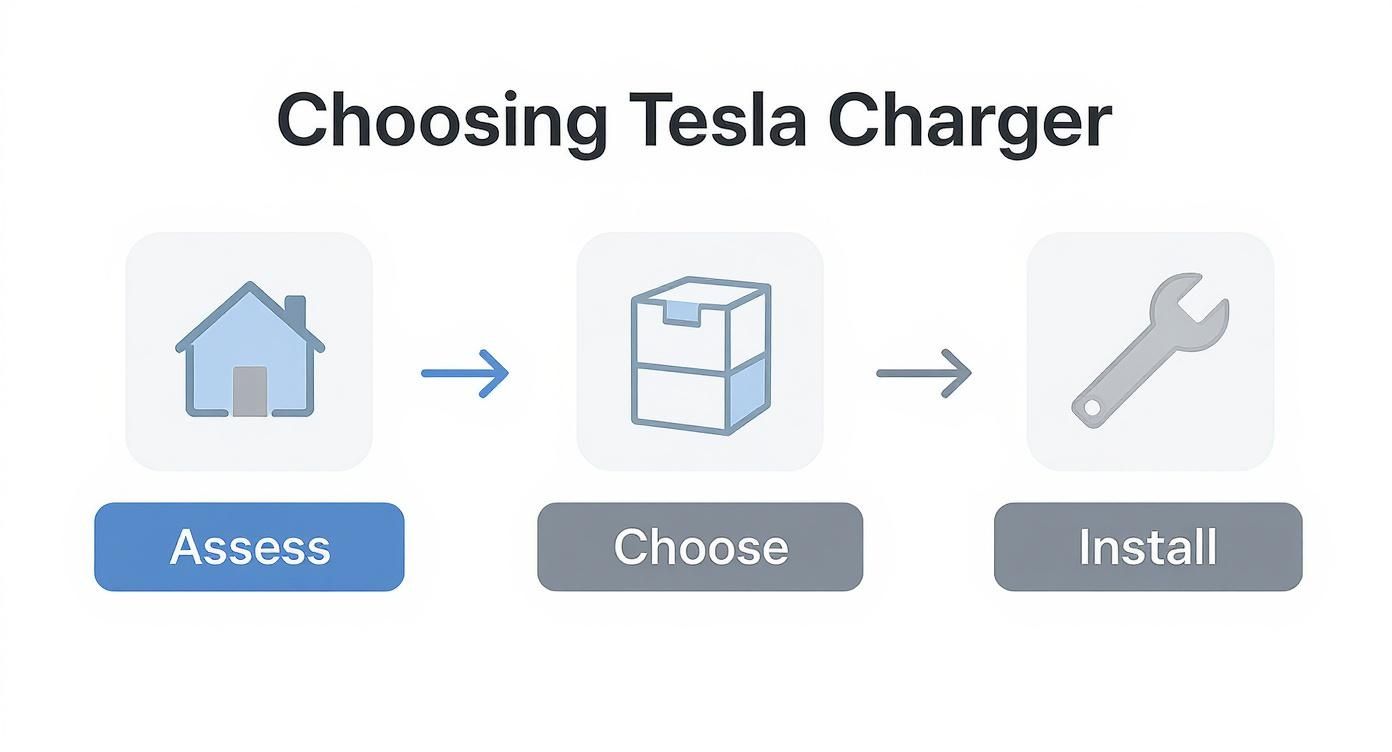
As you can see, a successful installation all starts with a good, hard look at your home’s electrical system before anyone starts drilling holes or running wires.
Your Electrical Consultation
When the electrician comes out for a consultation, they'll perform a few key checks. Their main focus will be your main electrical panel. They need to figure out its total capacity and see if there are any open slots for a new, dedicated circuit.
An experienced electrician will perform what’s known as a "load calculation." This crucial step ensures your home's electrical system can safely handle the added demand of an EV charger without overloading the circuit, especially when other large appliances are running.
Based on that assessment, they'll know exactly what kind of circuit to install. For a Tesla Wall Connector to deliver its fastest charging speeds, you'll typically need a dedicated 240-volt circuit paired with a 60-amp circuit breaker.
Overcoming Common Installation Hurdles
Of course, not every installation is a simple affair. A great electrician will spot potential roadblocks early and have a plan to deal with them.
Here are a few common issues that can pop up:
- A Full Electrical Panel: If your panel is already maxed out with breakers, don't worry. Your electrician can often install a smaller subpanel or use "tandem" breakers to cleverly create the space you need.
- Insufficient Panel Capacity: Older homes sometimes have a main service of only 100 amps, which might not be enough to support a powerful charger. This could mean a service upgrade is necessary, a bigger job that involves working with your local utility company.
- Long Wiring Run: Ideally, your charger will be installed close to your electrical panel. The farther away it is, the more expensive the job gets due to the extra wire and labor required. You can get a clearer picture of potential expenses by reading our guide on how much it costs to install an EV charger at home.
Calculating the Real Costs of Home Charging
One of the best perks of owning a Tesla is waking up to a "full tank" every morning, and doing it for pennies on the dollar compared to gas. But what does it actually cost to get set up and charge at home? Let's break down both the initial investment and the day-to-day expenses so you have a clear picture.
The main upfront expense is the hardware and the professional installation. While you can get by with the Mobile Connector, most owners eventually go for a hardwired Wall Connector because it’s faster and more convenient. The installation is where the costs can really swing, typically landing somewhere between $500 to over $1,500.
So, why such a big price range? It really boils down to a few things:
- Distance to Electrical Panel: The longer the run from your main breaker box to your garage or parking spot, the more copper wire and labor time are needed. This is often the biggest variable.
- Panel Capacity: If your home's electrical panel is already maxed out, it might not handle a new 240V circuit. An electrician might need to upgrade the panel, which adds a significant chunk to the bill.
- Labor Rates: The cost for a licensed electrician varies quite a bit depending on where you live. It's always a smart move to get a few quotes from installers who have experience with EV chargers.
Calculating Your Ongoing Charging Costs
Once you’re set up, the real savings kick in. Figuring out how much you'll spend to charge your Tesla is actually pretty simple. You only need two numbers: your car’s battery size (in kilowatt-hours, or kWh) and your electricity rate (in cents per kWh).
The math is easy:
Total Battery Size (kWh) x Your Electricity Rate ($ per kWh) = Cost for a Full Charge
For instance, charging a Tesla Model 3 from empty to full in the U.S. costs around $9.60, but this can change drastically based on your local utility rates. A huge tip: many owners slash their costs even further by charging during off-peak hours when electricity is cheapest, sometimes dropping to $0.08/kWh or less. You can explore more about EV charging trends in North America to see how these savings add up over time.
Estimated Cost for a Full Charge by Tesla Model
This chart shows the estimated cost to fully charge different Tesla models based on average and off-peak US electricity rates, illustrating potential savings.
gantt
title Cost to Fully Charge a Tesla
dateFormat X
axisFormat %S
section Model 3 RWD (60 kWh)
Off-Peak: $6.00: 0, 60
Average: $10.20: 0, 102
section Model Y Long Range (81 kWh)
Off-Peak: $8.10: 0, 81
Average: $13.77: 0, 138
section Model S/X (100 kWh)
Off-Peak: $10.00: 0, 100
Average: $17.00: 0, 170
It really highlights just how much you can save, especially when you tap into the cheaper off-peak rates that many utility companies offer. They provide these discounts to encourage energy use when the grid isn't under heavy demand, which is usually late at night.
| Tesla Model | Battery Size (Approx. kWh) | Cost at Average Rate ($0.17/kWh) | Cost at Off-Peak Rate ($0.10/kWh) |
|---|---|---|---|
| Model 3 RWD | 60 kWh | $10.20 | $6.00 |
| Model Y Long Range | 81 kWh | $13.77 | $8.10 |
| Model S | 100 kWh | $17.00 | $10.00 |
| Model X | 100 kWh | $17.00 | $10.00 |
The difference is night and day. Just by setting your Tesla to start charging after 11 PM, you could easily cut your "fuel" bill by 40% or more. It makes home charging an incredibly affordable way to power your daily commute.
Smart Charging Habits for Tesla Owners
Once your charger is up and running, a few simple habits can turn your garage into a seriously smart "gas station." This is about more than just plugging in your car; it's about being strategic to save money, protect your battery, and get the most out of your setup. Luckily, the best tool for the job is already in your pocket: the Tesla app.
The biggest win, by far, is scheduling your charging sessions. Instead of plugging in and charging immediately, you can use the app to tell your car to wait until off-peak hours. This is usually late at night when electricity demand plummets and your utility company offers much lower rates. By simply setting your car to start charging after, say, 11 PM, you could slash your charging costs by 40% or more. This single habit is the secret sauce to affordable EV ownership.
If you're curious about how these pricing plans work, we break it all down in our guide to time-of-use electricity rates.
Keep Your Battery Happy for the Long Haul
It's not just about saving a few bucks. How you charge directly impacts the long-term health of your battery. Think of it like a muscle: you don't want to strain it to its absolute max every single day.
Pro Tip: For your daily commute and errands, Tesla recommends setting your charge limit to 80%. This simple step reduces stress on the battery cells and is one of the best things you can do to preserve its capacity for years to come. Only push it to 100% when you're gearing up for a long road trip and need every last mile of range.
When you think about it, home charging handles an estimated 90% or more of an owner's needs, which makes these small habits incredibly powerful over the life of the car. It’s this convenience and control that truly defines the EV experience. For a deeper dive, check out these insights on North American EV charging trends.
A Few Lingering Questions About Home Charging
Even with all the details covered, a few specific questions tend to pop up. Let's walk through some of the most common situations people find themselves in so you can feel completely ready to make the switch.
Do I Need a Garage to Install a Home Charger?
Nope, a garage is definitely not a dealbreaker. The Tesla Wall Connector is built tough and is fully weather-resistant, meaning it's designed for both indoor and outdoor life. You can absolutely have it installed in a driveway, a carport, or on the side of your house.
A good electrician will run the wiring to your preferred spot, making sure everything is up to local code for an outdoor installation. It's a very common job for them.
Can I Charge My Tesla if I Live in an Apartment?
Charging in an apartment or condo can feel a bit trickier, but it’s becoming more and more common. The very first step is to start a conversation with your property manager, landlord, or HOA.
You might be surprised to learn that many areas have "right-to-charge" laws designed to help residents get access to EV charging. Usually, the process involves getting official permission and then finding an electrician to run power to your parking spot. You'll likely cover the cost, but it's a solid investment in your daily convenience.
How Much Will My Electricity Bill Increase?
This really comes down to two things: how much you drive and what you pay for electricity. Let's use a real-world example. If you drive about 1,000 miles a month, your Tesla will consume somewhere around 250-300 kWh of energy.
At the US average rate of $0.17 per kWh, you’re looking at an extra $42 to $51 on your monthly bill. When you compare that to the price of gas to cover the same distance, the savings are immediately obvious. This is where the real economic benefit of owning an EV shines.
Ready to make home charging a reality? The experts at Radiant Energy can design and install the perfect EV charging solution tailored to your home and driving needs. Explore your options and get a personalized quote today!

